
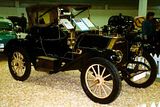



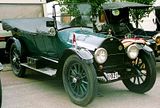
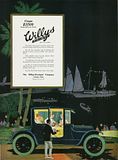

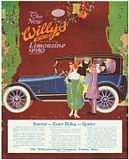
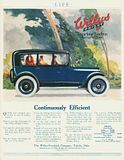





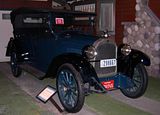


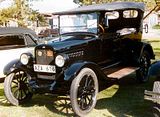



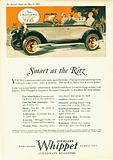

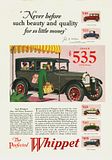


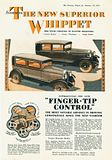
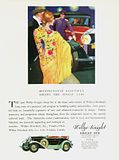
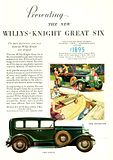
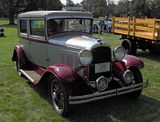
| » » » Willys Cars |
| 1901-1930 | 1931-1940 | 1941-1950 | 1951-1955 | 1956-1960 |
| 1912-1930 | 1931-1940 | 1941-1950 | 1951-1955 | 1956-1960 |
| 1931 Willys |
 |
| 1932 Willys |
 |
| 1933 Willys |
 |
| 1934 Willys |
 |
| 1935 Willys |
 |
| 1936 Willys |
 |
| 1937 Willys |
 |
| 1938 Willys |
 |
| 1939 Willys |
 |
| 1940 Willys |
 |
| 1912-1930 | 1931-1940 | 1941-1950 | 1951-1955 | 1956-1960 |
| 1941 Willys |
 |
| 1942 Willys |
 |
| 1943 Willys |
 |
| 1944 Willys |
 |
| 1945 Willys |
 |
| 1946 Willys |
 |
| 1947 Willys |
 |
| 1948 Willys |
 |
| 1949 Willys |
 |
| 1950 Willys |
 |
| 1912-1930 | 1931-1940 | 1941-1950 | 1951-1955 | 1956-1960 |
| 1951 Willys |
 |
| 1952 Willys |
 |
| 1953 Willys |
 |
| 1954 Willys |
 |
| 1955 Willys |
 |
| 1912-1930 | 1931-1940 | 1941-1950 | 1951-1955 | 1956-1960 |
| 1956 Willys |
 |
| 1957 Willys |
 |
| 1958 Willys |
 |
| 1959 Willys |
 |
| 1960 Willys |
 |
Willys (correctly pronounced "Will-is", but almost universally as "Will-eez") was the brand name used by Willys-Overland Motors, an American automobile company best known for its design and production of military Jeeps (MBs) and civilian versions (CJs) during the 20th century.
In 1908, John Willys bought the Overland Automotive Division of Standard Wheel Company and in 1912 renamed it Willys-Overland Motor Company. From 1912 to 1918, Willys was the second largest producer of automobiles in the United States after Ford Motor Company.
In 1913, Willys acquired a license to build the Charles Knight's sleeve-valve engine which it used in cars bearing the Willys-Knight nameplate. In the mid 1920s, Willys also acquired the F.B. Stearns Company of Cleveland, Ohio and assumed continued production of the Stearns-Knight luxury car as well.
John Willys acquired the Electric Auto-Lite Company in 1914 and in 1917 formed the Willys Corporation to act as his holding company. In 1916, they acquired the Russell Motor Car Company of Toronto, Ontario, Canada, by 1917 New Process Gear, and in 1919 acquired the Duesenberg Motors Company plant in Elizabeth, New Jersey. The New Jersey plant was replaced by a new, larger facility and was to be the site of production for a new Willys Six, but the 1920 recession brought the Willys Corporation to its knees. The bankers hired Walter P. Chrysler to sort out the mess and the first model to go was the Willys Six, deemed an engineering disaster. Chrysler had auto engineers Owen Skelton, Carl Breer and Fred Zeder begin work on a new car, the Chrysler Six.
In order to raise cash needed to pay off debts, all of the Willys Corporation assets were on the auction block. The Elizabeth plant and the Chrysler Six prototype were sold to William C. Durant, then in the process of building a new, third empire. The plant would build Durant's low priced Star, while the Chrysler Six prototype would be improved and modified, becoming the 1923 Flint.
Walter Chrysler moved on to Maxwell-Chalmers, where in January 1924 he launched his own version of the six-cylinder Chrysler he had been working on, one still based partially on elements originally developed at Willys. (In 1925 the Maxwell car company would become the Chrysler Corporation).
In 1926, production of the Overland ended and was replaced by the Whippet brand of small cars. Following the stock-market crash of 1929 and the economic depression that soon followed, a number of Willys automotive brands began to falter. Stearns-Knight was liquidated in 1929. Whippet production ended in 1931, its models replaced by the Willys Six and Eight. Production of the Willys-Knight ended in 1933.
At this point Willys decided to clear the boards and produce two new models — the 4-cylinder Willys 77 and the 6-cylinder Willys 99 — but the firm was on the verge of bankruptcy again, so only the 77 went into production. They were forced to sell their Canadian subsidiary, itself in weak financial shape, and started a massive reorganization. In it, only the main assembly plant and some smaller factories remained property of Willys-Overland. The rest were sold off to a new holding company that leased some of the properties back to W-O. The company was thus able to ride out the storm.
In 1936 the Willys-Overland Motor Company was reorganized as Willys-Overland Motors. In the 1920s and 1930s, Willys was an unremarkable automaker based in Toledo, Ohio, one of dozens in the U.S. However In 1937 Willys came out with a redesigned four which featured a semi-streamlined body with a slanted windshield, headlamps integrally embedded into the fenders and a one-piece, extremely rounded hood transversely hinged at the rear.
It was one of several bidders when the War Department sought an automaker who could begin rapid production of a lightweight truck based on a prototype designed by American Bantam.
In 1938 Joseph W. Frazer had joined Willys from Chrysler as chief executive. He saw a need to improve the firm's 4-cylinder engine to handle the punishment to which the Jeep would be subjected. This objective was brilliantly achieved by ex-Studebaker chief engineer Delmar "Barney" Roos, who wanted
"an engine that could develop 15 horsepower at 4,400 r.p.m. and run for 150 hours without failure. What he started with was an engine that developed 48 horsepower at 3,400 r.p.m., and could run continuously for only two to four hours. . . It took Barney Roos two years to perfect his engine, by a whole complex of revisions that included closer tolerances, tougher alloys, aluminum pistons, and a flywheel reduced in weight from fifty-seven to thirty-one pounds".
Production of the Willys MB, better known as Jeep, began in 1941, shared between Willys, Ford and American Bantam which had initiated the original Jeep body design. 8,598 units were produced that year, and 359,851 units were produced before the end of World War II. In total, 653,568 military Jeeps were eventually manufactured. The origin of the name "Jeep" has been debated for many years. Some people believe "Jeep" is a phonetic pronunciation of the abbreviation GP, from "General Purpose", that was used as part of the official Army nomenclature. The first documented use of the word "Jeep" was the name of a character Eugene the Jeep in the Popeye comic strip, known for his supernatural abilities (e.g., walking through walls). It was also the name of a small tractor made by Minneapolis Moline[citation needed] before WW2. Whatever the source, the name stuck and, after the war, Willys filed a successful trademark claim for the name.
At the end of the war, Willys did not resume production of its pre-war passenger car models, choosing instead to concentrate on Jeeps and Jeep-based vehicles. The first postwar Willys product was the CJ-2A. The CJ-2A was an MB stripped of obviously military features, particularly the blackout lighting, and with the addition of a tailgate.
Willys struggled to find a market for the unusual vehicle, and made an effort to sell it as an alternative to the farm tractor. Tractors were in short supply having been out of production during the war. Despite this, sales of the "Agri-Jeep" never took off, mainly because it was too light to provide adequate draft.
However, the CJ-2A was among the first civilian vehicles of any kind to be equipped with four-wheel drive from the factory. It gained popularity among farmers, ranchers, hunters, and others who needed a lightweight vehicle for use on unimproved roads and trails.
In 1946, a year after the introduction of the CJ-2A, Willys produced the Willys "Jeep" Utility Wagon based on the same engine and transmission, with clear styling influence from the CJ-2A Jeep. The next year came a "Jeep" Utility Truck with four-wheel drive. In 1948, the wagon was available in four-wheel drive, making it the ancestor of all sport utility vehicles.
The only vehicle that was not a four wheel drive that Willys offered in the first years after WW2 was the Willys 6-70 five place sedan. It name came from the fact it was powered by a 6-cylinder engine that produced 70 hp. The 6-70 was touted as the first stock car produced in America that offered independent suspension on all four wheels. Production of the Willys 6-70 was to start in 1947.
In 1948 under a contract from the US Army Willys produced a small one man four wheeled utility vehicle called the Jungle Burden Carrier which evolved into the M274 Utility 1/2 ton vehicle.
Willys later produced the M38 Jeep for the U.S. Army, and continued the CJ series of civilian Jeeps. Another variation of the Jeep was the Jeepster. A more civilized variation, it came with either a 4-cylinder or 6-cylinder engine but came only with two-wheel drive to the rear.
In 1952 Willys re-entered the car market with a new compact car, the Willys Aero. At first available only as a two door sedan, it was available with either an L-head or F-head six cylinder engine. Export markets could get the Aero with a four cylinder engine. A four door sedan and a two door hardtop were added for 1953 along with taxi models. The Aero cars were called Lark, Wing, Falcon, Ace or Eagle depending on year, engine and trim level, except for a small production run in its final year (1955) with models called Custom and Bermuda. Also in 1952, CJ3B Jeeps went into production. By 1968, over 155,000 were sold.
In 1953 Kaiser Motors purchased Willys-Overland and changed the name to Willys Motor Company. The same year, production of the Kaiser car was moved from Willow Run, Michigan to the Willys plant at Toledo, Ohio. Although Jeep production was steady, sales of the Willys and Kaiser cars continued to fall. In 1954, the CJ5 debuted at the start of its three-decade run.
After the last Willys passenger car was built in 1955, Willys shipped the tooling for the Aero to Brazil, where it was built from 1960 to 1962, almost unchanged. Brooks Stevens restyled it for 1963, and the Aero continued to be built by Ford after they purchased Willys-Overland do Brasil until the 1970s. The American company changed its name again in 1963 to Kaiser-Jeep Corporation, at which time the Willys name disappeared.
Kaiser-Jeep was sold to American Motors Corporation (AMC) in 1970 when Kaiser Industries decided to leave the automobile business. After the sale, AMC used engines it had developed for its other cars in the Jeep products to improve performance and standardize production and servicing.
Renault purchased a major stake in AMC in 1979 and took over operation of the company, producing the CJ series until 1986. Chrysler purchased AMC in 1987 after the CJ had already been replaced with the Jeep Wrangler (also known as the YJ and later TJ), which had little in common with the CJ series other than outward appearance. DaimlerChrysler, now Chrysler LLC, still produces Jeep vehicles at a brand new Toledo Complex.
DaimlerChrysler would introduce the Overland name for a trim package on the 2003–present Jeep Grand Cherokee. The badging is a recreation of the Overland nameplate from the early twentieth century.
|
|
Contents
Holden Cars |
Other HRDU SitesHot Rod EventsHot Rod History Hot Rod Hall of Fame Hot Rod Magazines Hot Rod Books Hot Rod Tech Hot Rod Tours Kustoms Memorabilia Show Rods Land Speed Australia Land Speed America LSR History LSR Historians |
More HRDU SitesAll About 1934 Chev's48-53 Chev Pickup's History of the Corvette Prototypes Car Spotters Guide Monaro Shrine Aussie Utes Wheelstanders Scallops Slopers |
AboutAbout Hot Rods Down UnderContact Us Copyright Disclaimer Terms and Conditions Privacy Site Map Hot Rods Down Under Movies Music TV Calendar Links Home |